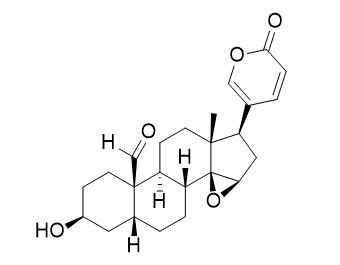Resibufagin
Resibufagin shows strong cytotoxic activity against HeLa cell line.
Inquire / Order:
manager@chemfaces.com
Technical Inquiries:
service@chemfaces.com
Tel:
+86-27-84237783
Fax:
+86-27-84254680
Address:
1 Building, No. 83, CheCheng Rd., Wuhan Economic and Technological Development Zone, Wuhan, Hubei 430056, PRC
Providing storage is as stated on the product vial and the vial is kept tightly sealed, the product can be stored for up to
24 months(2-8C).
Wherever possible, you should prepare and use solutions on the same day. However, if you need to make up stock solutions in advance, we recommend that you store the solution as aliquots in tightly sealed vials at -20C. Generally, these will be useable for up to two weeks. Before use, and prior to opening the vial we recommend that you allow your product to equilibrate to room temperature for at least 1 hour.
Need more advice on solubility, usage and handling? Please email to: service@chemfaces.com
The packaging of the product may have turned upside down during transportation, resulting in the natural compounds adhering to the neck or cap of the vial. take the vial out of its packaging and gently shake to let the compounds fall to the bottom of the vial. for liquid products, centrifuge at 200-500 RPM to gather the liquid at the bottom of the vial. try to avoid loss or contamination during handling.
Heliyon.2023, e12778.
Cosmetics2025, 12(3), 108
BMC Plant Biol.2021, 21(1):60.
J Adv Res.2021, 35:245-257.
Evid Based Complement Alternat Med.2017, 2017:9764843
Front Pharmacol.2025, 16:1611342.
Int J Mol Sci.2020, 21(8):2790.
Eur J Pharm Sci.2016, 94:33-45
Oxid Med Cell Longev.2021, 2021:6647107.
Biology (Basel).2020, 9(11):363.
Related and Featured Products
J Asian Nat Prod Res. 2008 Mar-Apr;10(3-4):233-7.
One new bufadienolide from Chinese drug [Pubmed:
18335338 ]
METHODS AND RESULTS:
A new bufadienolide named 16beta-acetoxy-bufarenogin (1), together with six known bufadienolides, namely, 11alpha,12beta-dihydroxy-bufalin (2), bufotalin (3), hellebrigenin (4), desacetylbufotalin (5), gamabufotalin (6), and Resibufagin (7) were isolated from Chan'Su. Of these, 2 was a new natural product. Their structures were elucidated by spectral methods.
CONCLUSIONS:
The cytotoxic activities in vitro of these compounds have been assayed against HeLa cell line. They all showed strong cytotoxic activities.
Zhongguo Zhong Yao Za Zhi. 2011 Nov;36(21):2987-93.
Inhibitory effect of total bufadienolides from toad venom against H22 tumor in mice and their metabolites.[Pubmed:
22308689]
To evaluate the inhibitory effect of total bufadienolides from toad venom against H22 tumor in mice and preliminarily analyze the structures of the metabolites in tissues.
METHODS AND RESULTS:
HPLC and LC-MS were used for analysis of the chemical composition of TBFs. High, middle and low dosages of TBFs were orally administered or intra-peritoneally injected to H22 tumor-bearing mice for thirteen days. The animals were killed and the tumors were stripped and weighed. The metabolites in the tissues such as heart, liver, spleen, lung and kidney, were analyzed by HPLC and LC-MS. The chemical composition of TBFs were identified by comparison of the retention times with those of reference substances, on-line UV spectra and MS data. Its main components are concerned with gamabufotalin, arenobufagin, bufotalin, Resibufagin, cinobufotalin, bufalin, cinobufagin and resibufogenin. TBFs had no obvious influence on body weight of H-22 tumor-bearing mice orally administered and the inhibition rate against tumor were 14.76%, 16.38% and 10.32% for low (5 mg x kg(-1)), middle (10 mg x kg(-1)) and high dosage (20 mg x kg(-1)), respectively. The mice intra-peritoneally injected with middle and high-dose of TBFs gained body weight slower than the control mice on the 5th day and recovered on the 13th day. The inhibition rate against tumor were 17.30%, 19.80% and 40.95% for low (1.5 mg x kg(-1)), middle (3 mg x kg(-1)) and high dose (6 mg x kg(-1)), respectively. The inhibitory effect took on dose-dependent manner. Based on the HPLC analyses on heart, liver, spleen, lung and kidney, bufadienolides were found in the liver tissue and 11 compounds of them were tentatively identified by LC-DAD-MS.
CONCLUSIONS:
TBFs by oral administration had no inhibitory effect against H22 tumor in mice, however, TBFs by intra-peritoneal injection displayed the significantly inhibitory effect, accompanying some toxicity for early duration of the study. The identification of bufadienolides in the liver provides a good basis for the further investigation of the metabolic pathways of TBFs in vivo.



